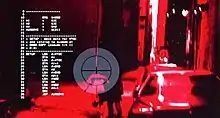MovieCode
MovieCode (full title Source Code in TV and Films) is a website revealing the meanings of computer program source code depicted in film, established in January 2014.
Type of site | Geek |
|---|---|
| Owner | John Graham-Cumming |
| URL | moviecode |
| Launched | January 3, 2014[3] |
| Current status | Online |
It runs via microblogging site Tumblr, with its owner accepting examples submitted by readers. Its contents include examples of code and their origins and/or meanings.
History
The site was launched on 3 January 2014 via microblogging service Tumblr.[4][5][6] It was conceived by programmer and writer John Graham-Cumming[7] to address questions around what the source code seen in films actually does.[5][8]
Graham-Cumming was inspired to create the blog by Neill Blomkamp's 2013 film Elysium, which uses an extract from an Intel manual.[6][9][10] He posted a comparison image related to the film on Twitter, which prompted more than 500 retweets. He then created the blog.[11] The site's full title of Source Code in TV and Films[3][7] is sometimes shortened to MovieCode,[12] that being the Tumblr subdomain.
Features
The site's intention is to connect screenshots to specific extracts of original code.[6] The author accepts examples submitted by readers for future publication.[1][2]
Reception
The site was reported by the BBC as having received more than 10,000 hits 10 days after its launch.[3]
The German edition of Engadget was noted for its web site's HTML code being used in Duane Clark's 2011 TV series XIII,[4][12] while it was noted elsewhere that movie code is frequently taken from web sites, including Wikipedia[5][14] and a Canadian bank.[10][14]
It was noted that instead of using "random code" (which is often the case) sometimes more appropriate code is used.[7] Some cited examples are James Cameron's 1984 film The Terminator (using assembly language for the 1975[15] MOS 6502 microprocessor),[5] Eric Kripke's 2012 TV series Revolution (using code from Jordan Mechner's 1989 video game Prince of Persia)[12][16] and David Fincher's[9] 2011 film The Girl with the Dragon Tattoo (using MySQL).[7]
See also
References
- "Movie code tumblr cracks the sources of code found in TV, film". Slate. Culture Blog. 6 January 2014. Retrieved 13 January 2014.
- Harris, Aisha (7 January 2014). "Que veulent dire les codes informatiques que l'on voit dans les films?". Slate. Retrieved 13 January 2014.
- Kleinman, Zoe (13 January 2014). "Computer programmer cracks secrets of films' dodgy code". BBC News. Retrieved 13 January 2014.
- Weiss, Franziska (4 January 2014). "Quelltext in TV und Film und was er wirklich beschreibt". Engadget. Retrieved 13 January 2014.
- Chan, Casey (5 January 2014). "What All The Fancy Code In Movie Computer Sequences Actually Mean". Gizmodo. Retrieved 13 January 2014.
- Cereloz, Axel (9 January 2014). "Le code présenté dans les films a-t-il réellement un sens ?". presse-citron.net. Retrieved 13 January 2014.
- Johnson, Phil (8 January 2014). "The sources of all that code you see in TV and movies". ITworld. Retrieved 13 January 2014.
- "Links: January 2014". Waxy.org. 3 January 2014. Retrieved 13 January 2014.
- Gani, Aisha (10 January 2014). "Computer code in films: hidden meanings or irrelevant nonsense?". The Guardian. Retrieved 13 January 2014.
- Sparkes, Matthew (13 January 2014). "Movie code reveals Iron Man was made of Lego". The Daily Telegraph. Retrieved 13 January 2014.
- Marvin, Rob (13 January 2014). "Programmer debunks source code shown in TV and movies". SD Times Blog. Retrieved 14 January 2014.
- Love, Dylan (10 January 2014). "Here's Proof That The Computer Code Used In Movies Is Mostly Nonsense". Business Insider. Retrieved 13 January 2014.
- Miller, Jennifer (7 January 2014). "What The Code Used In Computer Scenes In Movies Actually Means". Fast Company. Retrieved 13 January 2014.
- "3rd Generation Microprocessor" (PDF). Microcomputer Digest. Cupertino, CA: Microcomputer Associates. 2 (2): 1–3. August 1975.
- Crockett, Rebecca (8 January 2014). "Doctor Who Among TV & Movies To Use Fake Computer Code On Screen". Kasterborous. Retrieved 14 January 2014.
